
Rudy Gay was perceived as a game changer in Memphis. Yet the Grizzlies won their first playoff series in history in 2011 with Gay sporting street clothes on the sidelines. Following the trade that shipped the supposed superstar Gay to Toronto and earned Memphis just a feeble starter in Tayshaun Prince and a unproven prospect in Ed Davis, the Grizzlies stunningly benefited as they advanced all the way to uncharted territory: the Western Conference Finals. Unlike Memphis, the recipient of Gay’s services, the Raptors, sputtered in their tremendously short-termed affair. Instead of resurrecting Toronto, Gay led the team to a mediocre 24-30 record. All this insinuates that Gay’s inefficient playing style poses as basketball cancer. With the national belief that Gay can be an effective #1 option at an all time low, the desperate Sacramento Kings gambled on the turbulent UConn product. And boy, couldn’t both parties be any happier.
The criticism towards Gay has revolved around his inefficiencies. His numbers this season with Toronto highly reflected that. With the Raptors, Gay was 5th among Forwards in field goal attempts per game with 18.6. Yet Rudy was a whopping 81st in shot percentage at 38.8% per match. Gay’s high volume shooting stemmed from Toronto’s stagnant offense.
Toronto didn’t possess a legitimate pick and roll, shooting, or post up threat. Thus several times, the Raptors isolated Gay at the top of the perimeter and offered him no off-ball movement with the intent that Rudy can bail Toronto out of a bad possession. With limited ball handling skills, this play often resulted in a tough, contested Gay jumper. Rudy hoisted a ton of these discouraging shots, as he ranked 5th in field goal attempts 15-19 feet away from the basket. Toronto’s reliance on Gay to dig them out of an offensive hole is perfectly exemplified by his 4th ranked usage rate at 30.1%, only behind Anthony, James, and Durant. Even when Gay was able to smartly attack the basket, the predictability coming from Toronto giving him the ball allowed the defense’s rim protection to thwart his lay up attempt. Thus the Raptors relinquished their attempt to have Gay be their #1 option.

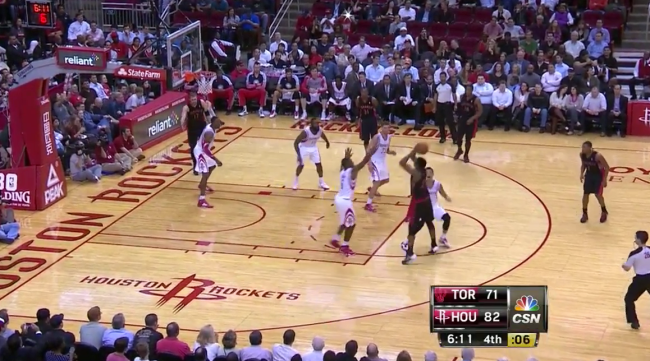 Here’s Gay receiving the ball late in the shot clock with Jones right in front of him. Toronto gives him no off ball movement and expects him to bail them out of what was a unproductive possession.
Here’s Gay receiving the ball late in the shot clock with Jones right in front of him. Toronto gives him no off ball movement and expects him to bail them out of what was a unproductive possession.
Intelligently Sacramento understood the talent Gay offered and that his inefficient stats derived from how Toronto utilized him. Thus the Kings decided to resort Gay to their third offensive option, behind the pick and roll between Thomas and Cousins and the Cousins post up. Gay’s decreased usage rate at 24.9% and field goal attempts per game at 14.7 (a career low) illustrates Sacramento’s decision to not force the ball through him. He now rarely receives the ball isolated at the top of the perimeter with the intent to attack the defender one on one.
Instead the Kings desire to exploit Gay’s play-making ability. Sacramento posts him up on an island in the mid range area. The primary intent is for Gay to utilize his size advantage to draw in multiple defenders and then deliver a crisp pass to the open man. The Kings also exploit Gay’s passing capabilities by running the pick and roll with him and Cousins. As a result, Rudy’s assist ratio (number of assists per 100 possessions) has improved from 8.5 in Toronto to 12.3.
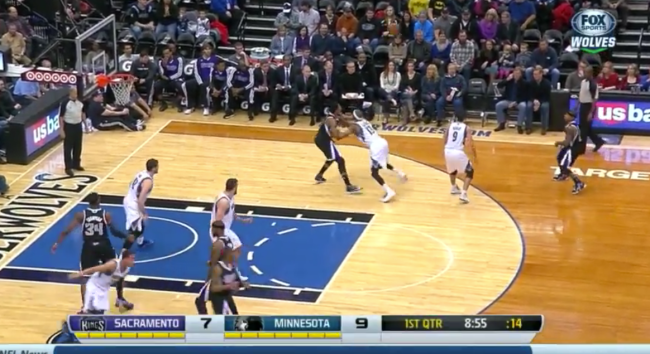
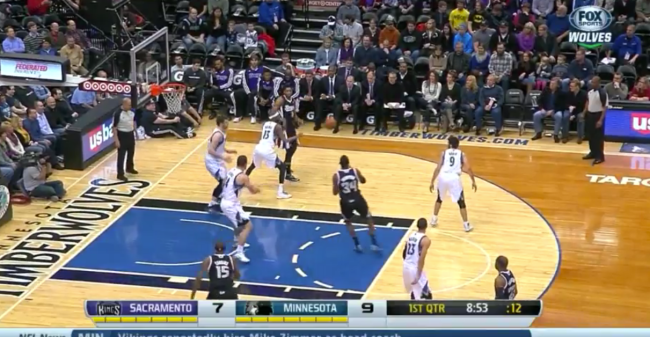 Thomas passes the Ball to Gay on an island. Love decides he wants to give help, which leaves Thompson open. And Gay finds him
Thomas passes the Ball to Gay on an island. Love decides he wants to give help, which leaves Thompson open. And Gay finds him
In addition to his play-making, Sacramento still takes advantage of Gay’s scoring. Rudy has earned career highs in points and field goal percentage per game in the capital of California. This stems from Gay posing more of a decoy for when Thomas or Cousins lures multiple defenders. He benefits from the space created by those aforementioned prolific offensive threats and attacks the basket. That room has aided Rudy tremendously, as Gay’s converting a remarkable 64.4% within 5 feet of the hoop as opposed to a miserable 47.4% with Toronto. He’s also unafraid to foray into the paint and attempt a relatively easy shot when Gay’s unable to create offensive activity for others via the post up. In Toronto, Gay would have rather turned around and taken a challenging fall-away jump shot. Lastly his athleticism allows him to be a terror in transition offensively, and he always positions himself to get a good shot by hustling and running down the court.
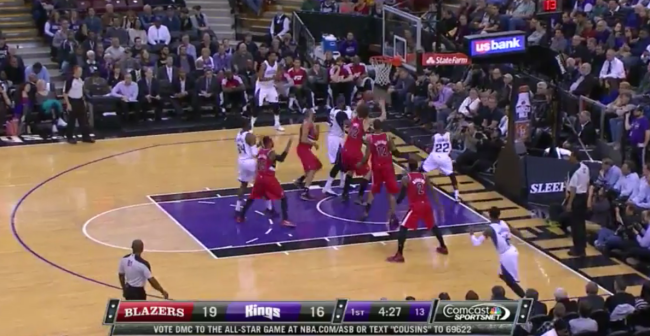
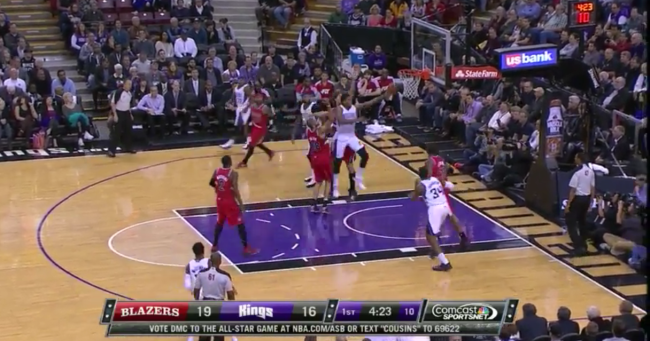 Thomas gets into the lane and draws multiple defenders. Gay spots up at the corner 3, which leaves him wide open. Thomas gets him the ball, then Gay smartly uses the space to take it to the hoop.
Thomas gets into the lane and draws multiple defenders. Gay spots up at the corner 3, which leaves him wide open. Thomas gets him the ball, then Gay smartly uses the space to take it to the hoop.
Sacramento has been known for it’s inability to develop talent, exemplified by first round draft picks Tyreke Evans and Jimmer Fredette plateauing very early in their career. Yet their approach to utilize Gay by treating him as a play-making decoy has rejuvenated his career, as his true shooting percentage has increased from 46.8% to 60.6% with the Kings. Add his suddenly efficient play to his above average on ball defense and superb ability to play the passing lanes, and Gay should certainly be considered as a top 25 player in the league and for Most Improved Player this year.